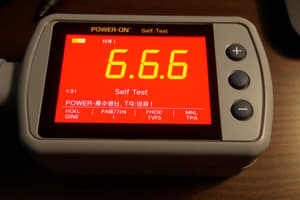Podcast
Questions and Answers
What does 1 long and 1 short beep indicate?
What does 1 long and 1 short beep indicate?
- Memory problem
- Motherboard issue (correct)
- Video card failure
- Power supply issue
Which beep code corresponds to a CMOS battery failure?
Which beep code corresponds to a CMOS battery failure?
- 6 beeps
- 5 beeps (correct)
- 4 beeps
- 7 beeps
Which of the following codes indicates a RAM read/write test failure in Phoenix BIOS?
Which of the following codes indicates a RAM read/write test failure in Phoenix BIOS?
- 1-2-2-3
- 1-1-2
- 1-3-1-1
- 1-3-4-1 (correct)
What is a common cause of continuous beeping during startup?
What is a common cause of continuous beeping during startup?
What is the likely issue if a system emits 3 long beeps?
What is the likely issue if a system emits 3 long beeps?
What does POST stand for in the context of computers?
What does POST stand for in the context of computers?
Which of the following components does the POST process check?
Which of the following components does the POST process check?
What happens if POST detects a hardware error?
What happens if POST detects a hardware error?
What is indicated by continuous beeps during the POST process?
What is indicated by continuous beeps during the POST process?
Which beep code indicates a processor error according to AMI BIOS?
Which beep code indicates a processor error according to AMI BIOS?
What is the significance of beep codes during the boot process?
What is the significance of beep codes during the boot process?
What action does the system take after successfully completing the POST process?
What action does the system take after successfully completing the POST process?
Which combination of beeps indicates a video adapter error in Award BIOS?
Which combination of beeps indicates a video adapter error in Award BIOS?
Flashcards are hidden until you start studying
Study Notes
Power-On Self-Test (POST)
- POST stands for Power-On Self-Test, a diagnostic process initiated when powering on a computer.
- The computer’s firmware, usually in BIOS or UEFI, conducts hardware checks on components like the processor, RAM, and storage devices.
- If issues are found during the tests, POST reports them through beep codes or error messages.
- No significant errors prompt POST to initialize hardware and prepare it for the operating system.
- Upon successful completion, POST leads to the selection of a bootable device to load the operating system.
Beep Codes
- Beep codes are auditory signals emitted by the BIOS to indicate hardware issues during the boot process.
- These codes assist in diagnosing problems when visual error displays are unavailable.
- The beep patterns vary across BIOS manufacturers, providing specific indications of different hardware failures.
AMI (American Megatrends) BIOS Beep Codes
- 1 short beep: DRAM refresh failure.
- 2 short beeps: Parity circuit failure.
- 3 short beeps: Base 64 KB memory failure.
- 5 short beeps: Processor error.
- 6 short beeps: Keyboard controller error.
- 8 short beeps: Display memory error.
- Continuous beeps: Power supply, motherboard, or keyboard issue.
Award BIOS Beep Codes
- 1 long, 2 short beeps: Video adapter error.
- 1 long, 3 short beeps: Video resolution issue.
- Continuous short beeps: Power or motherboard problem.
- Repeating high/low beeps: CPU overheating.
IBM BIOS Beep Codes
- 1 short beep: Normal POST, system is booting.
- 2 short beeps: POST error, check screen for details.
- Continuous beep: Power supply, motherboard, or memory issue.
- 1 long, 1 short beep: Motherboard issue.
- 3 long beeps: Keyboard problem.
Dell BIOS Beep Codes
- 1 beep: BIOS ROM failure.
- 2 beeps: Unrecognized RAM.
- 3 beeps: Motherboard failure.
- 4 beeps: RAM read/write failure.
- 5 beeps: CMOS battery failure.
- 6 beeps: Video card failure.
- 7 beeps: Processor failure.
Phoenix BIOS Beep Codes
- Uses a combination of beeps resembling Morse code for diagnostics.
- Specific codes:
- 1-1-2: CPU failure.
- 1-2-2-3: BIOS ROM checksum error.
- 1-3-1-1: DRAM refresh failure.
- 1-3-1-3: Base 64 KB memory failure.
- 1-3-4-1: RAM read/write test failure.
Common Causes of Beep Codes
- Memory (RAM) failure: Often indicated by beep codes and can usually be fixed by reseating or replacing RAM.
- Video card failure: Systems commonly signal issues related to the video card through beep codes.
- CPU overheating: Persistent beeping may indicate overheating or other CPU-related issues.
- Power supply issues: Beep codes can signal failures related to power supply or motherboard.
- Knowing beep codes aids in troubleshooting, especially when visual outputs are not available; always refer to specific BIOS documentation for accurate interpretations.
Studying That Suits You
Use AI to generate personalized quizzes and flashcards to suit your learning preferences.




